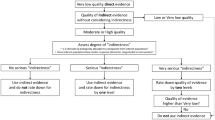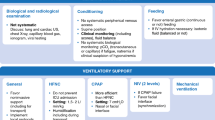Abstract
Improvements in diagnostic and therapeutic modalities of antenatal care has meant that the neonatal intensive care units (NICU) need to care for infants with complex congenital conditions who need ongoing care post discharge. This, along with improved survival of the extreme preterm infants, provides the neonatal team with a cohort of infants who require long-standing multi-disciplinary input. However, provision of dedicated teams looking after infants with complex medical needs is not commonly reported in NICU workforce structure. The objective of this study is to perform a scoping review of literature on the presence of structured and dedicated complex care management teams in neonatal intensive care unit and their outcomes on care delivery. A scoping review was undertaken to identify all reported literature on existence of chronic care teams in NICU searching medical databases. A narrative synthesis of results was prepared.
Conclusions: The review identified very few clinical models reported with no robust data on clinical outcome measures.
What is Known: • Neonatal units are increasingly providing care for infants who require chronic ongoing input from multiple specialties or allied health professionals. A majority of this cohort is formed by extreme preterm infants who require long term respiratory support or nutritional rehabilitation. • There are examples of dedicated clinical teams looking after complex patients in adult and pediatric intensive care outfits leading to improvements in outcome. | |
What is New: • This is first literature review in the authors’ knowledge on the use of complex care teams in neonatal intensive care unit. • This article provides a narrative synthesis of the clinical models that have been used by complex care teams in neonatal intensive care unit and whether they have demonstrated tangible benefits in patient outcome. |
Similar content being viewed by others
Data availability
Not applicable
Code availability
Not applicable
Abbreviations
- BPD:
-
Bronchopulmonary Dysplasia
- s-BPD:
-
Severe- Bronchopulmonary Dysplasia
- CCN:
-
Complex care needs
- CLD:
-
Chronic Lung Disease
- CPAP:
-
Continuous Positive Airway Pressure
- CQC:
-
Care Quality Commission
- EQUATOR:
-
Enhancing the Quality and Transparency Of health Research
- ED:
-
Emergency department
- FiO2:
-
Fractional Inspired Oxygen
- IMV:
-
Intermittent Mandatory Ventilation
- LTV:
-
Long term ventilation
- MDT:
-
Multidisciplinary Team
- NICU:
-
Neonatal intensive care unit
- PMA:
-
Post menstrual age
- QI:
-
Quality Improvement
- UK:
-
United Kingdom
- USA:
-
United States of America
References
Fraser LK, Parslow RC, McKinney PA et al (2012) Life limiting and life-threatening conditions in children and young people in the United Kingdom: Final Report for Together for Short Lives
Wallis C, Paton JY, Beaton S et al (2011) Children on long-term ventilatory support: 10 years of progress. Arch Dis Child 96(11):998–1002. https://doi.org/10.1136/adc.2010.192864 (Epub 2010 Nov 24 PMID: 21109507)
Brenner M, Kidston C, Hilliard C et al (2018) Children’s complex care needs: a systematic concept analysis of multidisciplinary language. Eur J Pediatr 177(11):1641–1652. https://doi.org/10.1007/s00431-018-3216-9
Hewitt-Taylor J, Farasat H (2006) Learning to support children with complex needs in their homes. Br J Community Nurs 11:209–213
Breneol S, Belliveau J, Cassidy C et al (2017) Strategies to support transitions from hospital to home for children with medical complexity: a scoping review. Int J Nurs Stud 72:91–104
Enlow E, Herbert SL, Jovel IJ et al (2014) Neonatal intensive care unit to home: the transition from parent and pediatrician perspectives, a prospective cohort study. J Perinatol: official journal of the California Perinatal Association 34(10):761–6
Tricco AC, Lillie E, Zarin W et al (2018) PRISMA extension for scoping reviews (PRISMA-ScR): checklist and explanation. Ann Intern Med 169:467–473
Kieran E, Sara R, Claydon J, Hait V et al (2019) Outcomes of neonates with complex medical needs. Adv Neonatal Care. 19(4):275–284 https://doi.org/10.1097/ANC.0000000000000639 (PMID: 31268866)
Boos VD, Okah FA, Swinton CH et al (2010) The comprehensive care rounds: facilitating multidisciplinary communication among caregivers of complex patients in the neonatal intensive care unit. Adv Neonatal Care 10(6):301–6. https://doi.org/10.1097/ANC.0b013e3181f36e4c (PMID: 21102172)
Welch CD, Check J, O’Shea TM (2017) Improving care collaboration for NICU patients to decrease length of stay and readmission rate. BMJ Open Quality 6:e000130. https://doi.org/10.1136/bmjoq-2017-000130
McKinney RL, Shukla K, Daigle K et al (2013) The BIT:S (Bronchopulmonary Dysplasia Interdisciplinary Team: Severe) initiative at women and infants hospital of Rhode Island. R I Med J 102(3):22–25. (PMID: 30943667)
Hansen TP, Noel-MacDonnell J, Kuckelman S et al (2021) A multidisciplinary chronic lung disease team in a neonatal intensive care unit is associated with increased survival to discharge of infants with tracheostomy. J Perinatol 41(8):1963-1971. https://doi.org/10.1038/s41372-021-00974-2. (Epub 2021 Apr 1. PMID: 33795789; PMCID: PMC8013205)
Zhang H, Nilan K, Dysart K et al (2018) Caring for infants with severe chronic lung disease (cld) - five year experience of a multidisciplinary care program. Pediatrics 141 (1_MeetingAbstract):506. https://doi.org/10.1542/peds.141.1MA6.506
Kieran E, Dyck CL, Shivananda S (2020) Strengthening care for infants with medical complexity during the transition from the neonatal intensive care unit to the community. Paediatrics & Child Health 25(Suppl 2):e11–e12. https://doi.org/10.1093/pch/pxaa068.030
Care Quality Commission (2016) Identifying and managing clinical risks in newborn babies and providing care for infants in the community who need respiratory support
Desai AD, Durkin LK, Jacob-Files EA et al (2016) Caregiver perceptions of hospital to home transitions according to medical complexity: a qualitative study. Acad Pediatr 16(2):136–44
Leyenaar JK, O’Brien ER, Leslie LK et al (2017) Families’ priorities regarding hospital-to-home transitions for children with medical complexity. Pediatrics 139:1
Carosella A, Snyder A, Ward E (2018) What parents of children with complex medical conditions want their child’s physicians to understand. JAMA Pediatr 172(4):315–6
Micah PDJ, Godfrey C, Patricia M et al (2022) Best practice guidance and reporting items for the development of scoping review protocols. JBI Evidence Synthesis: April 20(4):953–968. https://doi.org/10.11124/JBIES-21-00242
Acknowledgements
The authors would like to acknowledge the contribution of Amy Ward, clinical librarian of East Lancashire Hospital NHS Trust, for helping with the systematic search.
Author information
Authors and Affiliations
Contributions
AS, AP and SS conceptualised the project. AS and AP carried out preliminary literature search and reviewed results of the search carried out by clinical librarian. AS and AP reviewed the selected articles independently and collated results and conclusions. AS drafted the primary manuscript. AP and SS helped edit and all authors approve the final version.
Corresponding author
Ethics declarations
Ethics approval
Not applicable
Consent to participate
Not applicable
Consent for publication
Not applicable
Competing interests
The authors declare no competing interests.
Additional information
Communicated by Daniele De Luca
Publisher's Note
Springer Nature remains neutral with regard to jurisdictional claims in published maps and institutional affiliations.
Appendix 1. Ovid search strategy (Literature search done on 22/12/2021)
Appendix 1. Ovid search strategy (Literature search done on 22/12/2021)
-
1.
newborn/
-
2.
neonat*.mp. [mp=title, abstract, heading word, drug trade name, original title, device manufacturer, drug manufacturer, device trade name, keyword heading word, floating subheading word, candidate term word]
-
3.
“new born”.mp. [mp=title, abstract, heading word, drug trade name, original title, device manufacturer, drug manufacturer, device trade name, keyword heading word, floating subheading word, candidate term word]
-
4.
infant/
-
5.
(“complex care” or “complex care team” or “neonatal complex care team” or “neonatal complex care”).mp. [mp=title, abstract, heading word, drug trade name, original title, device manufacturer, drug manufacturer, device trade name, keyword heading word, floating subheading word, candidate term word]
-
6.
1 or 2 or 3 or 4
-
7.
intensive care.mp. or intensive care/
-
8.
critical care.mp.
-
9.
“neonatal intensive care”.mp. or newborn intensive care/
-
10.
(ICU or NICU).mp. [mp=title, abstract, heading word, drug trade name, original title, device manufacturer, drug manufacturer, device trade name, keyword heading word, floating subheading word, candidate term word]
-
11.
“complex care model”.mp. [mp=title, abstract, heading word, drug trade name, original title, device manufacturer, drug manufacturer, device trade name, keyword heading word, floating subheading word, candidate term word]
-
12.
NCCT.mp. [mp=title, abstract, heading word, drug trade name, original title, device manufacturer, drug manufacturer, device trade name, keyword heading word, floating subheading word, candidate term word]
-
13.
7 or 8 or 9 or 10 or 12
-
14.
5 or 11 or 12
-
15.
6 and 13 and 14
Appendix 2. PRISMA flow diagram

Rights and permissions
About this article
Cite this article
Sur, A., Paria, A. & Sivashankar, S. Management pathway for infants requiring chronic care in neonatal units—a scoping review of practices. Eur J Pediatr 181, 3235–3242 (2022). https://doi.org/10.1007/s00431-022-04542-4
Received:
Revised:
Accepted:
Published:
Issue Date:
DOI: https://doi.org/10.1007/s00431-022-04542-4




